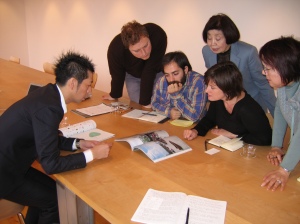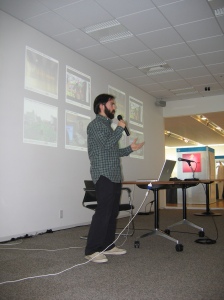 In his new book, Rules of Thumb: 52 Truths for Winning at Business without Losing Yourself, Alan Webber stimulates, inspires, challenges and helps us understand what makes for a life well-lived and work well-done.
In his new book, Rules of Thumb: 52 Truths for Winning at Business without Losing Yourself, Alan Webber stimulates, inspires, challenges and helps us understand what makes for a life well-lived and work well-done.
Reflecting 40 years of experience as observer, participant and agent provocateur, Alan has gathered 52 gems of wisdom on how to lead and innovate in these extraordinary times.
I recently caught up with Alan in cyberspace to talk with him about his new book.
Q: It seems your book is well timed, as it’s abundantly clear the old rules of thumb for business are no longer working. Inspirational serendipity or calculated marketing?
A: Mostly serendipity–with a dash of foresight. The idea for the book began with a talk I gave a little more than a year ago to the CEO and top 50 executives of a large company. At the end of the formal program, the CEO asked his team, “Who in the United States has moral authority?” There was a long uninterrupted silence. You could see people going through their mental Rolodexes: who in business? who in government? who in organized religion? No one came up with a name. It made me reflect on how much we need new sources of clear thinking–and how, ultimately, we are all going to have to generate our own new rules for work and life. That realization sent me back to my files where I’ve kept articles, speeches, and essays that I’ve written over the last 30-plus years–working in Portland, Oregon, at the Harvard Business Review, at Fast Company, and more recently as a self-defined “global detective.” I was able to crystallize a set of rules that I’d learned from a remarkable group of men and women with whom I’d worked. Those rules form the backbone of Rules of Thumb. So you could say that I saw this current disconnect coming–or you could say that I’m a product of it. Both are true.
Q: You talk a lot about context trumping content in the post-information age. You also say new realities demand new categories. How do you think sudden shifts in context we’ve had in the global economy over the last year will play out in driving innovation and creating new value?
A: I can’t remember a time in the last 30 years when the United States and the world are as ready for a new conversation. Where ever I travel–most recently to Denmark–people are eager to talk about new ways of solving old problems. They’re looking for solutions that aren’t confined to our old categories. In fact, many people agree with my statement in the book that our old categories often allow the problems to persist: the problems have learned how to live in the cracks of our categories. None of this will be easy; old habits, including habits of mind, die hard. But I think you can find examples around the world of business innovation–and perhaps more important, social innovation–that will produce fresh ways for people to work, live, and find meaning in their lives.
Q: You mention books like “In Search of Excellence” (1982) by Tom Peters and Bob Waterman, and “Good to Great” (2001) by Jim Collins. If business leaders have been keen to read these books and hear these people speak, why don’t they seem able to follow their advice?
A: I know plenty of business leaders (and leaders in government and non-profit organizations) who take very seriously the good ideas presented by these two books and many others that offer advice and counsel to people trying to lead their institutions. But inspiration is easier than application: as you know from my book, one of the rules is “Knowin’ it ain’t the same as doin’ it.” Reading advice and following it are two entirely different things. That’s one of the reasons I structured RULES the way I did. I believe that change comes from within–from things we come to terms with as individuals, whether in business or daily life. By sharing some of my own experiences, describing the lessons they’ve taught me, and suggesting that everyone of us is capable of paying attention to the people we meet, the experiences we have, and the rules we learn, I hope to provoke readers to become both committed learners and their own best teachers. Once you embrace something that you’ve discovered yourself, you’re much more likely to apply it.
Q: Rule #41 says “If you want to be a real leader, first get real about leadership.” What are the most important qualities of leadership that are lacking in leaders today?
A: One of my criticisms of the business press for the last 30 years is that it tends to worship at false images of leadership, especially in business. We’ve become a culture of celebrity. If a CEO gets big enough, rich enough, and famous enough to qualify as a leader, that’s enough! The leaders I’ve worked with and who I admire most were never motivated by fame or celebrity. Their first allegiance was to the people they were leading, to the organization they all were part of, and to the mission they were trying to achieve. We all know the difference in our own lives between working for a leader who’s all about themselves and a leader who’s all about the work we’re doing together. Particularly as we simultaneously try to recover from this devastating economic collapse (caused in large part, I would argue, by the first kind of leader, the ones who were only out for the glory and the money) and to solve pressing national and global social and environmental problems, we need to embrace a different style of leadership. (By the way, I’m promoting a new national “day”: Celebrity-Free News Day, I call it. Imagine a day when the news wouldn’t have a single celebrity story! Who’s with me on this?) In RULES I write about leaders who have strong and healthy egos, but who aren’t raging narcissists–who know how to check their egos at the door. Leaders who know how to ask the right questions, rather than assuming that they have all the answers. Leaders who bring together a talented team, rather than presuming to be the smartest person in the room–in any room! I think we’ve all worked with leaders who know how to bring out the best we have to offer, and leaders who have the title but not the feel for doing the job the right way.
Q: One of my favorite rules is #50: “On the way up pay attention to your strengths; they’ll be your weaknesses on the way down”. You say this can be true of people, companies, industries, – even nation states. Given the current state of the U.S. economy, what advice do you have for President Obama?
A: Well, so far President Obama hasn’t asked for my advice! But I suspect he may have already learned this rule from his work as a community organizer, in part: one thing community organizers learn how to do is to practice the art of political ju-jitsu where you use the strengths of your larger, richer, stronger opponent against them. That may be why so much of his communication about solving America’s problems focuses on reminding us of our time-honored values: taking responsibility for our actions, telling the truth and respecting the rule of law and the Constitution. For those who believe that we’ve allowed our strengths to become weaknesses by ignoring them or allowing them to lose their luster, part of President Obama’s message that resonates is a reminder of what America has traditionally stood for. Whether you’re a country or a company, knowing your values is a critical place to start any re-building process. You have to know what is negotiable, and what is not. The core isn’t negotiable–those are rules that don’t get re-written. The rest–how to solve problems, create new policies, develop new products and services, and the rules that can help you do those things–all that is up for debate.
Q: Rule #28 states: “Great design wins.” How does design relate to quality and making things work?
A: Great design has to work or it isn’t design, it’s just decoration! It doesn’t matter whether you’re talking about the design of a product or service design, winning in the world of competition means using design not only to delight the eye or enhance the experience but also to produce genuine quality and outcomes that work. One company I mention in RULES is OXO, one of the best designers of kitchen products. Their stuff looks great and has excellent quality–but they begin their designs by looking for ways to make something as mundane as a vegetable peeler flat out work better. Fit your hand better, clean easier, and peel better. By the way, one tip I heard in Denmark on my last trip–and the Danes, like the Japanese, think they’ll compete in the future on the quality of their design–is to be aware of service design. As services become a larger and larger part of the economy, we need to be applying the rules of design to the service sector. The companies that do it sooner and better will gain real advantages with customers, who care about their service quality as much, or more, as they do about product quality.
Q: In rule #5 you state: “Change is a math formula.” In other words, change happens when the cost of the status quo is greater than the risk of change. Do you think we’ve reached that point in history on a global scale?
A: No question about it. All over the world in my travels, I encounter people who are willing to try new things. They see the status quo as an impediment to innovation and the search for solutions that work to address problems that matter. At the same time, we’re all still human–and with that comes an attachment to the ways of working and living that we’ve grown comfortable with. Letting go is still hard. But as the severity of our problems increases and the inability of existing institutions and categories to produce viable results becomes more apparent people are looking for new directions and new approaches. I don’t want to pretend that change is fun and easy. But there comes a time when you have to let go of whatever you’re clutching–because it’s an impediment to finding something better. You can see this happening in a wide variety of issues and problems, public and private, around the world. I just read a quote from Sir Howard Stringer, Chairman and CEO of SONY, who said, “What this recession has done is expose the weaknesses in our system that we didn’t want really to admit.” That’s the cost of the status quo suddenly being greater than the risk of change.
Q: Throughout your book, you stress the importance of passion and loving what you do. In rule #39 you talk about how “serious fun” isn’t an oxymoron; rather, it’s how to win. And rule #1 Rule dictates that “When the going gets tough, the tough relax”. How do you teach attitude?
A: This takes us back to your earlier question about leadership. One of the things that real leaders do is to set an example through their personal conduct and their ways of doing business. There are still too many leaders who think that the way to motivate people is through fear. It doesn’t work, it’s never worked, and in a knowledge economy it never will work. People in organizations want to be challenged, they want to be inspired, they want to be given a chance to contribute and to grow–but I don’t know anyone who wakes up in the morning eager to go to work with the idea, “I can’t wait to be intimidated and humiliated today!” So if you’re a leader, your job is to create an environment where people can do their best work. That doesn’t mean you can’t criticize people when they need to have a mistake pointed out–actions do have consequences. But overall, smart and talented people want to work in a place where they can do their best work and feel like it makes a difference. So, to answer your question, if you’re a leader, the best way to teach attitude is to embody it yourself. And if you’re trying to lead from below, the best way to teach attitude is to show the boss how you want to be lead. You can, after all, lead up!
Q: Rule #9 says “Nothing happens until money changes hands.” This rule seems counter to some of the more idealistic rules in your book. Is money always necessary for innovation to occur?
A: This was a rule I learned in my own experience as an entrepreneur, trying to start Fast Company magazine. And it’s a cautionary rule. I know so many smart, energetic, idealistic entrepreneurs who seem to think that their ideas are all they need–that somehow the market will discover them and reward them simply for thinking innovative thoughts. But it’s not an innovation unless it actually gets to the market–until it gets to the market it’s just an idea. The hard truth is, if you want your idea to become an innovation, you’ll need to find the money to make it happen. As I say in the book, entrepreneurs need to have a sign on their desks, “The buck starts here.”
Q: You’ve been a Japan Society U.S.-Japan Society Leadership Fellow and also involved with the U.S.-Japan Innovators Network. How important a role has Japan played in the formulation of your 52 rules?
A: I’ve benefited enormously from being a part of the Japan Society, and the book reflects those benefits. There are rules that come directly out of my experiences with the Japan Society, but even more important is the human network that I began to learn from my Japan Society fellowship and that is the real source of the 52 rules. Behind almost every rule is a person or experience; that awareness of the way our lives interconnect was something my first introduction to the Japan Society impressed on me. So there are specific rules (and people will have to read the book to discover them), specific people, and also the general principle that I trace back to the many years of involvement I’ve had with the Japan Society.
Q: Rule #10 in your book states “A good question beats a good answer”. How’d I do?
A: Daniel, you’ve always asked good questions! That’s one of the reasons there’s an Innovators Network today! We should do this again–it’s always more fun, more engaging, and more valuable to have someone asking great questions!
—-
Rules of Thumb: 52 Truths for Winning at Business without Losing Yourself, published by HarperCollins, hits bookstores April 21.
Read Full Post »
 Innovators Network member
Innovators Network member 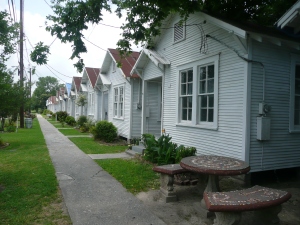



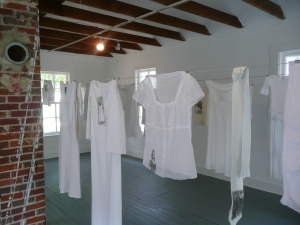

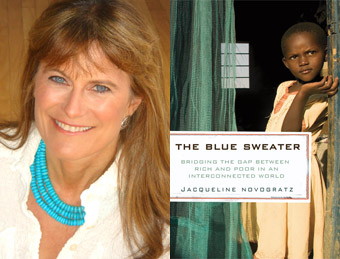
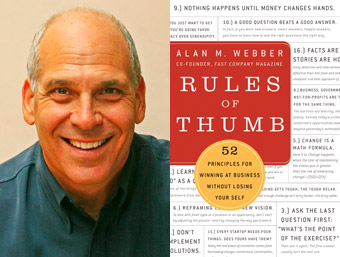 U.S.-Japan Innovators Network Lecture
U.S.-Japan Innovators Network Lecture In his new book,
In his new book,